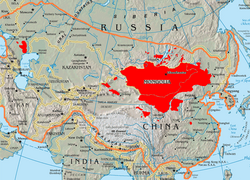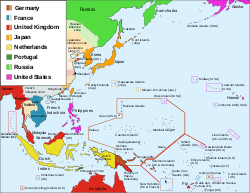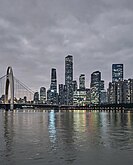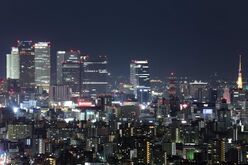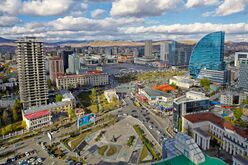Place:East Asia
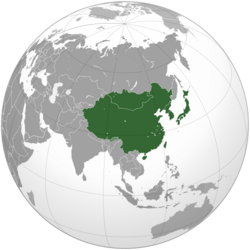 | |
| Area | 11,840,000 km2 (4,570,000 sq mi) (3rd) |
|---|---|
| Population | 1.6 billion (2023; 4th) |
| Population density | 141.9 km2 (54.8 sq mi) |
| GDP (PPP) | $44.7 trillion (2023)[1] |
| GDP (nominal) | $24.8 trillion (2023)[1] |
| GDP per capita | $15,000 (nominal)[1] |
| Demonym | East Asian |
| Countries | |
| Dependencies | |
| Languages | |
| Time zones | UTC+7, UTC+8 & UTC+9 |
| Largest cities | List of urban areas:[6] |
| UN M49 code | 030 – Eastern Asia142 – Asia001 – World |
| East Asia |
|---|
East Asia is a region of Asia, which is defined in both geographical and ethno-cultural terms.[7][8] The modern states of East Asia include China , Japan , Mongolia, North Korea, South Korea , and Taiwan.[2][3][4][5] Hong Kong and Macau, two small coastal cities located in the south of China, are autonomous regions under Chinese sovereignty. The economies of Japan, South Korea, China, Taiwan, Hong Kong, and Macau are some of the world's largest and most prosperous economies.[9] East Asia borders Siberia and the Russian Far East to the north, Southeast Asia to the south, South Asia to the southwest, and Central Asia to the west. To the east is the Pacific Ocean and to the southeast is Micronesia (a Pacific Ocean island group that is classified as part of Oceania).
East Asia, especially Chinese civilization, is regarded as one of the earliest cradles of civilization. Other ancient civilizations in East Asia that still exist as independent countries in the present day include the Japanese, Korean and Mongolian civilizations. Various other civilizations existed as independent polities in East Asia in the past but have since been absorbed into neighbouring civilizations in the present day, such as Tibet, Baiyue, Khitan, Manchuria, Ryukyu (Okinawa) and Ainu, among many others. Taiwan has a relatively young history in the region after the prehistoric era; originally, it was a major site of Austronesian civilization prior to colonisation by European colonial powers and China from the 17th century onward. For thousands of years, China was the leading civilization in the region, exerting influence on its neighbours.[10][11][12] Historically, societies in East Asia have fallen within the Chinese sphere of influence, and East Asian vocabularies and scripts are often derived from Classical Chinese and Chinese script. The Chinese calendar serves as the root from which many other East Asian calendars are derived.
Major religions in East Asia include Buddhism (mostly Mahayana),[13] Confucianism and Neo-Confucianism, Taoism,[14] ancestral worship, and Chinese folk religion in Mainland China, Hong Kong, Macau and Taiwan, Shinto in Japan, and Christianity, and Musok in Korea.[15][16][17] Tengerism and Tibetan Buddhism are prevalent among Mongols and Tibetans while other religions such as Shamanism are widespread among the indigenous populations of northeastern China such as the Manchus.[18] Major languages in East Asia include Mandarin Chinese, Japanese, and Korean. Major ethnic groups of East Asia include the Han (mainland China, Hong Kong, Macau, Taiwan), Yamato (Japan) and Koreans (North Korea, South Korea). Mongols, although not as populous as the previous three ethnic groups, constitute the majority of Mongolia's population. There are 76 officially-recognized minority or indigenous ethnic groups in East Asia; 55 native to mainland China (including Hui, Manchus, Chinese Mongols, Tibetans, Uyghurs and Zhuang in the frontier regions), 16 native to the island of Taiwan (collectively known as Taiwanese indigenous peoples), one native to the major Japanese island of Hokkaido (the Ainu) and four native to Mongolia (Turkic peoples). Ryukyuan people are an unrecognized ethnic group indigenous to the Ryukyu Islands in southern Japan, which stretch from Kyushu Island (Japan) to Taiwan. There are also several unrecognized indigenous ethnic groups in mainland China and Taiwan.
East Asian people comprise around 1.7 billion people, making up about 33% of the population in Continental Asia and 20% of the global population.[19][20][21][needs update] The region is home to major world metropolises such as Beijing, Hong Kong, Osaka , Seoul, Shanghai, Shenzhen, Taipei and Tokyo. Although the coastal and riparian areas of the region form one of the world's most populated places, the population in Mongolia and Western China, both landlocked areas, is very sparsely distributed, with Mongolia having the lowest population density of a sovereign state. The overall population density of the region is 133 inhabitants per square kilometre (340/sq mi), about three times the world average of 45/km2 (120/sq mi).[when?][citation needed]
History
China was the first region settled in East Asia and was undoubtedly the core of East Asian civilization from where other parts of East Asia were formed.[22] The various other regions in East Asia were selective in the Chinese influences they adopted into their local customs. Historian Ping-ti Ho famously labeled Chinese civilization as the "Cradle of Eastern Civilization", in parallel with the "Cradle of Middle Eastern Civilization" along the Fertile Crescent encompassing Mesopotamia and Ancient Egypt[23] as well as the Cradle of Western Civilization encompassing Ancient Greece [lower-alpha 1] and Ancient Rome.[lower-alpha 2]
Chinese civilization existed for about 1,500 years before other East Asian civilizations emerged into history, Imperial China would exert much of its cultural, economic, technological, and political muscle onto its neighbours.[39][40][41][42] Succeeding Chinese dynasties exerted enormous influence across East Asia culturally, economically, politically and militarily for over two millennia.[42][43][44] The Imperial Chinese tributary system shaped much of East Asia's history for over two millennia due to Imperial China's economic and cultural influence over the region, and thus played a huge role in the history of East Asia in particular.[45][46][41] Imperial China's cultural preeminence not only led the country to become East Asia's first literate nation in the entire region, it also supplied Japan and Korea with Chinese loanwords and linguistic influences rooted in their writing systems.[47]
Under Emperor Wu of Han, the Han dynasty made China the regional power in East Asia, projecting much of its imperial power on its neighbours.[42][48] Han China hosted the largest unified population in East Asia, the most literate and urbanised as well as being the most economically developed, as well as the most technologically and culturally advanced civilization in the region at the time.[49][50] Cultural and religious interaction between the Chinese and other regional East Asian dynasties and kingdoms occurred. China's impact and influence on Korea began with the Han dynasty's northeastern expansion in 108 BC when the Han Chinese conquered the northern part of the Korean peninsula and established a province called Lelang. Chinese influences were transmitted and soon took root in Korea through the inclusion of the Chinese writing system, monetary system, rice culture, philosophical schools of thought, and Confucian political institutions.[51] Jomon society in ancient Japan incorporated wet-rice cultivation and metallurgy through its contact with Korea. Starting from the fourth century AD, Japan incorporated the Chinese writing system which evolved into Kanji by the fifth century AD and has become a significant part of the Japanese writing system.[52] Utilizing the Chinese writing system allowed the Japanese to conduct their daily activities, maintain historical records and give form to various ideas, thoughts, and philosophies.[53] During the Tang dynasty, China exerted its greatest influence on East Asia as various aspects of Chinese culture spread to Japan and Korea.[54][55] The establishment of the medieval Tang dynasty rekindled the impetus of Chinese expansionism across the geopolitical confines of East Asia. Similar to its Han predecessor, Tang China reasserted itself as the center of East Asian geopolitical influence during the early medieval period which spearheaded and marked another golden age in Chinese history.[56] During the Tang dynasty, China exerted its greatest influence on East Asia as various aspects of Chinese culture spread to Japan and Korea.[54][55] In addition, Tang China also managed to maintain control over northern Vietnam and Korea.[57]
As full-fledged medieval East Asian states were established, Korea by the fourth century AD and Japan by the seventh century AD, Japan and Korea actively began to incorporate Chinese influences such as Confucianism, the use of written Han characters, Chinese style architecture, state institutions, political philosophies, religion, urban planning, and various scientific and technological methods into their culture and society through direct contacts with Tang China and succeeding Chinese dynasties.[54][55][58] Drawing inspiration from the Tang political system, Prince Naka no oe launched the Taika Reform in 645 AD where he radically transformed Japan's political bureaucracy into a more centralised bureaucratic empire.[59] The Japanese also adopted Mahayana Buddhism, Chinese style architecture, and the imperial court's rituals and ceremonies, including the orchestral music and state dances had Tang influences. Written Chinese gained prestige and aspects of Tang culture such as poetry, calligraphy, and landscape painting became widespread.[59] During the Nara period, Japan began to aggressively import Chinese culture and styles of government which included Confucian protocol that served as a foundation for Japanese culture as well as political and social philosophy.[60][61] The Japanese also created laws adopted from the Chinese legal system that was used to govern in addition to the kimono, which was inspired from the Chinese robe (hanfu) during the eighth century AD.[62] For many centuries, most notably from the 7th to the 14th centuries, China stood as East Asia's most advanced civilization and foremost military and economic power, exerting its influence as the transmission of advanced Chinese cultural practices and ways of thinking greatly shaped the region up until the nineteenth century.[63][64][65][66]
As East Asia's connections with Europe and the Western world strengthened during the late nineteenth century, China's power began to decline.[39][67] By the mid-nineteenth century, the weakening Qing dynasty became fraught with political corruption, obstacles and stagnation that was incapable of rejuvenating itself as a world power in contrast to the industrializing Imperial European colonial powers and a rapidly modernizing Japan.[68][69] The U.S. Commodore Matthew C. Perry would open Japan to Western ways, and the country would expand in earnest after the 1860s.[70][71][72] Around the same time, Japan with its rush to modernity transformed itself from an isolated feudal samurai state into East Asia's first industrialised nation in the modern era.[73][74][71] The modern and militarily powerful Japan would galvanise its position in the Orient as East Asia's greatest power with a global mission poised to advance to lead the entire world.[73][75] By the early 1900s, the Japanese empire succeeded in asserting itself as East Asia's most dominant power.[75] With its newly found international status, Japan would begin to challenge the European colonial powers and inextricably took on a more active geopolitical position in East Asia and world affairs at large.[76] Flexing its nascent political and military might, Japan soundly defeated the stagnant Qing dynasty during the First Sino-Japanese War as well as vanquishing imperial rival Russia in 1905; the first major military victory in the modern era of an East Asian power over a European one.[77][78][79][80][70] Its hegemony was the heart of an empire that would include Taiwan and Korea.[73] During World War II, Japanese expansionism with its imperialist aspirations through the Greater East Asia Co-Prosperity Sphere would incorporate Korea, Taiwan, much of eastern China and Manchuria, Hong Kong, and Southeast Asia under its control establishing itself as a maritime colonial power in East Asia.[81] After a century of exploitation by the European and Japanese colonialists, post-colonial East Asia saw the defeat and occupation of Japan by the victorious Allies as well as the division of China and Korea during the Cold War. The Korean peninsula became independent but then it was divided into two rival states, while Taiwan became the main territory of de facto state Republic of China after the latter lost Mainland China to the People's Republic of China in the Chinese Civil War. During the latter half of the twentieth century, the region would see the post war economic miracle of Japan, which ushered in three decades of unprecedented growth, only to experience an economic slowdown during the 1990s, but nonetheless Japan continues to remain a global economic power. East Asia would also see the economic rise of Hong Kong, South Korea, and Taiwan, in addition to the respective handovers of Hong Kong and Macau near the turn of the twentieth century. The onset of the 21st-century in East Asia led to the integration of Mainland China into the global economy through its entry in the World Trade Organization while also enhancing its emerging international status as a potential world power reinforced with its aim of restoring its historical established significance and enduring international prominence in the world economy.[2][82][83][84][85][86][87][88][89] Despite the absence of armed conflicts in East Asia for decades, the stability of the region remains delicate due to the presence of North Korea's nuclear program and Chinese geopolitical encroachment and provocations occurring in Taiwanese waters. These tensions have emerged from the contentious relationship between Mainland China and Taiwan, as the former seeks to reunify with Mainland China while the latter strives to maintain its sovereign independence and preserve the prevailing geopolitical order.
Definitions
In common usage, the term "East Asia" typically refers to a region including Greater China, Japan , Korea and Mongolia.[83][90][91][92][93][94][95][96][97][98]
China , Japan , and Korea represent the three core countries and civilizations of traditional East Asia - as they once shared a common written language, culture, as well as sharing Confucian philosophical tenets and the Confucian societal value system once instituted by Imperial China.[99][100][101][102][103] Other usages define Mainland China, Hong Kong, Macau, Japan, North Korea, South Korea and Taiwan as countries that constitute East Asia based on their geographic proximity as well as historical and modern cultural and economic ties, particularly with Japan and Korea having strong cultural influences that originated from China.[99][103][104][105][106][107] Some scholars include Vietnam as part of East Asia as it has been considered part of the greater Chinese sphere of influence. Though Confucianism continues to play an important role in Vietnamese culture, Chinese characters are no longer used in its written language and many scholarly organizations classify Vietnam as a Southeast Asian country.[108][109][110] Mongolia is geographically north of Mainland China yet Confucianism and the Chinese writing system and culture had limited impact on Mongolian society. Thus, Mongolia is sometimes grouped with Central Asian countries such as Turkmenistan, Kyrgyzstan, and Kazakhstan.[108][109] Xinjiang (East Turkestan) and Tibet are sometimes seen as part of Central Asia.[111][112][113]
Broader and looser definitions by international agencies and organisations such as the World Bank refer to East Asia as the "three major Northeast Asian economies, i.e. China , Japan, and South Korea ", as well as Mongolia, North Korea, the Russian Far East, and Siberia.[114] The Council on Foreign Relations includes the Russia Far East, Mongolia, and Nepal.[115] The World Bank also acknowledges the roles of Chinese special administrative regions Hong Kong and Macau, as well as Taiwan, a country with limited recognition. The Economic Research Institute for Northeast Asia defines the region as "China, Japan, the Koreas, Nepal, Mongolia, and eastern regions of the Russia ".[116]

The UNSD definition of East Asia is based on statistical convenience,[118] but others commonly use the same definition of Mainland China, Hong Kong, Macau, Mongolia, North Korea, South Korea, Taiwan, and Japan.[7][119]
Certain Japanese islands are associated with Oceania due to non-continental geology, distance from mainland Asia or biogeographical similarities with Micronesia.[120][121] Some groups, such as the World Health Organization, categorize China, Japan and Korea with Australia and the rest of Oceania. The World Health Organization label this region the "Western Pacific", with East Asia not being used in their concept of major world regions. Their definition of this region further includes Mongolia and the adjacent area of Cambodia, as well as the countries of the South East Asia Archipelago (excluding East Timor and Indonesia).[122]
Alternative definitions
In business and economics, "East Asia" is sometimes used to refer to the geographical area covering ten Southeast Asian countries in ASEAN, Greater China, Japan and Korea. However, in this context, the term "Far East" is used by the Europeans to cover ASEAN countries and the countries in East Asia. However, being a Eurocentric term, Far East describes the region's geographical position in relation to Europe rather than its location within Asia. Alternatively, the term "Asia Pacific Region" is often used in describing East Asia, Southeast Asia as well as Oceania.[citation needed] On rare occasion, the term is also sometimes taken to include India and other South Asian countries not within the bounds of the Pacific, although the term Indo-Pacific is more commonly used for such a definition.[123]
Observers preferring a broader definition of "East Asia" often use the term Northeast Asia to refer to China, the Korean Peninsula, and Japan, with Southeast Asia covering the ten ASEAN countries. This usage, which is seen in economic and diplomatic discussions, is at odds with the historical meanings of both "East Asia" and "Northeast Asia".[124][125][126] The Council on Foreign Relations of the United States defines Northeast Asia as Japan and Korea.[115]
Economy
| Customs territory | GDP nominal billions of USD (2023)[1] |
GDP nominal per capita USD (2023)[1] |
GDP PPP billions of USD (2023)[1] |
GDP PPP per capita USD (2023)[1] |
|---|---|---|---|---|
| 17,700,899 | 12,541 | 32,897,929 | 23,309 | |
| 385,546 | 51,168 | 548,999 | 72,861 | |
| 38,480 | 54,296 | 69,565 | 98,157 | |
| 4,230,862 | 33,950 | 6,495,214 | 52,120 | |
| 18,782 | 5,348 | 52,989 | 15,088 | |
| N/A | N/A | N/A | N/A | |
| 1,709,232 | 33,147 | 2,924,189 | 56,709 | |
| 751,930 | 32,339 | 1,685,358 | 72,485 | |
| East Asia | $24,835,731 | $15,068 | $44,674,243 | $27,104 |
Territorial and regional data
China, North Korea, South Korea and Taiwan are all unrecognised by at least one other East Asian state because of severe ongoing political tensions in the region, specifically the division of Korea and the political status of Taiwan.
Etymology
| Flag | Common Name | Official name | ISO 3166 Country Codes[127] | |||||
|---|---|---|---|---|---|---|---|---|
| Exonym | Endonym | Exonym | Endonym | ISO Short Name | Alpha-2 Code | Alpha-3 Code | Numeric | |
| China | 中国 | People's Republic of China | 中华人民共和国 | China | CN | CHN | 156 | |
| Hong Kong | 香港 | Hong Kong Special Administrative Region of the People's Republic of China |
中華人民共和國香港特別行政區 | Hong Kong | HK | HKG | 344 | |
| Macau | 澳門 | Macao Special Administrative Region of the People's Republic of China |
中華人民共和國澳門特別行政區 | Macao | MO | MAC | 446 | |
| Japan | 日本 | Japan | 日本国 | Japan | JP | JPN | 392 | |
| Mongolia | Монгол улс / ᠮᠣᠩᠭᠣᠯ ᠤᠯᠤᠰ |
Mongolia | Монгол Улс (ᠮᠣᠩᠭᠣᠯ ᠤᠯᠤᠰ) |
Mongolia | MN | MNG | 496 | |
| North Korea | 조선 | Democratic People's Republic of Korea | 조선민주주의인민공화국 | Korea (the Democratic People's Republic of) | KP | PRK | 408 | |
| South Korea | 한국 | Republic of Korea | 대한민국 | Korea (the Republic of) | KR | KOR | 410 | |
| Taiwan[lower-alpha 6] | 臺灣 / 台灣 | Republic of China | 中華民國 | Taiwan[127] | TW | TWN | 158 | |
Demographics
| State/Territory | Area km2 | Population in | % of East Asia | % of World | Population density per km2 |
HDI[130] | Capital/Administrative Centre |
|---|---|---|---|---|---|---|---|
| 9,640,011[lower-alpha 7] | 1,425,671[lower-alpha 8] | 85.76% | 17.72% | 138 | 0.768 | Beijing | |
| 1,104 | 7,492 | 0.45% | 0.093% | 6,390 | 0.952 | Hong Kong | |
| 30 | 704 | 0.042% | 0.0087% | 18,662 | 0.922 | Macao | |
| 377,930 | 123,295 | 7.42% | 1.53% | 337 | 0.925 | Tokyo | |
| 1,564,100 | 3,447 | 0.2% | 0.042% | 2 | 0.739 | Ulaanbaatar | |
| 120,538 | 26,161 | 1.57% | 0.33% | 198 | 0.733[citation needed] | Pyongyang[lower-alpha 9] | |
| 100,210 | 51,784 | 3.11% | 0.64% | 500 | 0.925 | Seoul | |
| 36,197 | 23,923 | 1.44% | 0.297% | 639 | 0.926 | Taipei[lower-alpha 10] | |
| East Asia | 11,840,000 | 1,662,477 | 100% | 20.66% | 141 |
Ethnic groups
| Ethnicity | Native name | Population | Language(s) | Writing system(s) | Major states/territories* | Traditional attire |
|---|---|---|---|---|---|---|
| Han/Chinese | 漢族 or 汉族 | 1,313,345,856[134] | Chinese (Mandarin, Min, Wu, Yue, Jin, Gan, Hakka, Xiang, Huizhou, Pinghua, etc.) | Simplified Han characters, Traditional Han characters | File:Hanfu Man and lady.jpg | |
| Yamato/Japanese | 大和民族 | 125,117,000[135] | Japanese | Han characters (Kanji), Katakana, Hiragana | 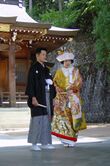
| |
| Korean | 조선민족 (朝鮮民族) 한민족 (韓民族) |
84,790,105[136][137][138] | Korean | Hangul, Han characters (Hanja) | 
| |
| Bai | 白族 | 2,091,543[139] | Bai, Southwestern Mandarin | Simplified Han characters, Latin script | 
| |
| Hui | 回族 | 11,377,914[139] | Northwestern Mandarin, other Chinese Dialects, Huihui language, etc. | Simplified Han characters[lower-alpha 11] | 
| |
| Mongols | Монголчууд ᠮᠣᠩᠭᠣᠯᠴᠤᠳ Монгол/ᠮᠣᠩᠭᠣᠯ |
8,942,528 | Mongolian | Mongol script, Cyrillic script | 
| |
| Zhuang | 壮族/Bouxcuengh | 19,568,546[139] | Zhuang, Southwestern Mandarin, etc. | Simplified Han characters, Latin script | 
| |
| Uyghurs | 维吾尔族/ئۇيغۇر | 11,774,538[139] | Uyghur | Arabic alphabet, Latin script | 
| |
| Manchus | 满族/Template:ManchuSibeUnicode | 10,423,303[139] | Northeastern Mandarin, Manchu language | Simplified Han characters, Mongol script | 
| |
| Hmong/Miao | 苗族/Ghaob Xongb/Hmub/Mongb | 11,067,929[139] | Hmong/Miao, Southwestern Mandarin | Latin script, Simplified Han characters | 
| |
| Tibetans | 藏族/བོད་པ་ | 7,060,731[139] | Tibetan, Rgyal Rong, Rgu, etc. | Tibetan script | 
| |
| Yi | 彝族/ꆈꌠ | 9,830,327[139] | Various Loloish, Southwestern Mandarin | Yi script, Simplified Han characters | 
| |
| Tujia | 土家族 | 9,587,732[139] | Northern Tujia, Southern Tujia | Simplified Han characters | 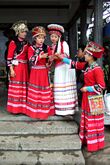
| |
| Kam | 侗族/Gaeml | 3,495,993[139] | Gaeml | Simplified Han characters, Latin script | 
| |
| Tu | 土族/Monguor | 289,565 | Tu, Northwestern Mandarin | Simplified Han characters | 
| |
| Daur | 达斡尔族/ᠳᠠᠭᠤᠷ | 131,992 | Daur, Northeastern Mandarin | Mongol script, Simplified Han characters | 
| |
| Indigenous Taiwanese Peoples | 臺灣原住民/ 高山族/ Yincomin/ Kasetaivang/ Inanuwayan | 533,600 | Austronesian languages (Amis, Yami), etc. | Latin script, Traditional Han characters | ||
| Ryukyuan | 琉球民族 | 1,900,000 | Japanese Ryukyuan |
Han characters (Kanji), Katakana, Hiragana | 
| |
| Ainu | アイヌ/ Aynu/ Айну | 200,000 | Japanese Ainu[140] |
Han characters (Kanji), Katakana, Hiragana | 
|
- Note: The order of states/territories follows the population ranking of each ethnicity, within East Asia only.
East Asian culture
Overview
The culture of East Asia has largely been influenced by China, as it was the civilization that had the most dominant influence in the region throughout the ages that ultimately laid the foundation for East Asian civilization.[141] The vast knowledge and ingenuity of Chinese civilization and the classics of Chinese literature and culture were seen as the foundations for a civilized life in East Asia. Imperial China served as a vehicle through which the adoption of Confucian ethical philosophy, Chinese calendar system, political and legal systems, architectural style, diet, terminology, institutions, religious beliefs, imperial examinations that emphasised a knowledge of Chinese classics, political philosophy and cultural value systems, as well as historically sharing a common writing system reflected in the histories of Japan and Korea.[142][42][143][144][145][146][147][148][103] The Imperial Chinese tributary system was the bedrock of network of trade and foreign relations between China and its East Asian tributaries, which helped to shape much of East Asian affairs during the ancient and medieval eras. Through the tributary system, the various dynasties of Imperial China facilitated frequent economic and cultural exchange that influenced the cultures of Japan and Korea and drew them into a Chinese international order.[149] The Imperial Chinese tributary system shaped much of East Asia's foreign policy and trade for over two millennia due to Imperial China's economic and cultural dominance over the region, and thus played a huge role in the history of East Asia in particular.[46][149] The relationship between China and its cultural influence on East Asia has been compared to the historical influence of Greco-Roman civilization on Europe and the Western World.[146][144][149][142]
Religions
Religion in East Asia (2020)[150]
| Religion | Native name | Creator/Current Leader | Founded Time | Main Denomination | Major book | Type | Est. Followers | Ethnic groups | States/territories |
|---|---|---|---|---|---|---|---|---|---|
| Chinese folk religion | 中國民間信仰 or 中国民间信仰 | Spontaneous formation | Prehistoric period | Salvationist, Wuism, Nuo | Chinese classics, Huangdi Sijing, precious scrolls, etc. | Prehistoric, pantheism, and polytheism | ~900,000,000[151][152] | Han, Hmong, Qiang, Tujia (worship of the same ancestor-gods) | |
| Taoism | 道教 | All religions originating in East Asia have been heavily influenced by Taoism and the Tao Te Ching.[14]
Zhang Daoling, was considered the founder of Taoism by Taoists. He founded Zhengyi, the earliest denomination of Taoism. Zhang Daoling reformed the Chinese folk religion from Sichuan, into a real, organised, and regulated religion, in 125 AD. Wang Chongyang founded the Quanzhen Denomination. Tale says Wang Chongyang met two Gods, Lü Dongbin and Han Zhongli, during Jin dynasty (1115–1234) in 1159. He then get started to study Taoism himself. Three years later, he finished his studying, and founded Quanzhen. The new leader of Zhengyi need to be the son or paternal nephew of the previous leader, confirmed by the court of Zhengyi, in Mount Longhu, Jiangxi. Also beginning from the Song dynasty, the leaders of Zhengyi get started to be confirmed and titled by the Emperor of China. In 1949, the 63rd leader, Zhang Enfu, fled to Taiwan with Chiang Kai-shek, leader of the Kuomintang, died in 1969 in Taipei. The Kuomintang Authority titled his cousin Zhang Yuanxian as the 64th leader, while the Court of Zhengyi back in Jiangxi argued that the oracle already foreseen the leadership will end at the 63rd generation. Zhang Yuanxian died in 2008, only left a daughter as heir. Meanwhile, the Kuomintang Authority did not confirmed the next leader. On the other hand, in Mainland China, Zhang Enfu's second daughter's son, Lu Jintao, changes his surname to Zhang, and get in charge of the Court of Zhengyi currently. For the leader of Quanzhen, the last (18th) leader (1335-1362) was Wanyan Deming, titled by the Emperor of Yuan dynasty. Wanyan Deming was a Jurchen Taoist, the Wanyan family was the imperial house of Jin dynasty. There is no official leader of Quanzhen after Wanyan Deming anymore.[citation needed] |
125 AD Eastern Han dynasty[citation needed] | Zhengyi, Quanzhen | Tao Te Ching | Pantheism, polytheism | ~20,000,000[152] | Han, Zhuang, Hmong, Yao, Qiang, Tujia | |
| East Asian Buddhism/Chinese Buddhism | 漢傳佛教 or 汉传佛教 | The Emperor of the Eastern Han dynasty, Liu Zhuang, made a dream about the Buddha occasionally, then sent people to the Western Regions to Introduce Buddhism to the Capital, Chang'an, in 67 AD. In 384 AD, during the Eastern Jin dynasty, Indian Mālānanda introduced the Chinese Buddhism to Baekje. In 552 AD, King Seong of Baekje offered Buddhism to the Emperor Kinmei of Japan.[citation needed] | 67 AD Eastern Han dynasty | Mahayana | Diamond Sutra | Non-God, Dualism. | ~300,000,000 | Han, Koreans, Yamato | |
| Tibetan Buddhism | 藏传佛教/བོད་བརྒྱུད་ནང་བསྟན། | Tonpa Shenrab Miwoche, Prince of the Ancient Xang Xung Kingdom. | 1800 years ago | Mahayana, Bon | Anuttarayoga Tantra | Non-God | ~10,000,000 | Tibetans, Manchus, Mongols | |
| Shamanism[lower-alpha 13] | 萨满教 or Бөө мөргөл | Spontaneous formation | Prehistoric period | N/A | Prehistoric, polytheism, and pantheism | N/A | Manchus, Mongols, Oroqens | ||
| Shinto | 神道 | Spontaneous formation | Yayoi period[153] | Shinto sects | Kojiki, Nihon Shoki | Prehistoric, pantheism, and polytheism | N/A | Yamato | |
| Musok/Muism | 신도 or 무교 | Spontaneous formation | Musok sects | N/A | Prehistoric, pantheism, and polytheism | N/A | Koreans | ||
| Ryukyuan religion | 琉球神道 or ニライカナイ信仰 | Spontaneous formation | N/A | N/A | N/A | Prehistoric, pantheism, and polytheism | N/A | Ryukyuans |
Festivals
| Festival | Native Name | Other name | Calendar | Date | Gregorian date | Activity | Religious practices | Food | Major ethnicities | Major states/territories |
|---|---|---|---|---|---|---|---|---|---|---|
| Chinese New Year | 農曆新年/农历新年 or 春節/春节 | Spring Festival | Chinese | Month 1 Day 1 | 21 Jan–20 Feb | Family Reunion, Ancestors Worship, Tomb Sweeping, Fireworks | Worship the King of Gods | Nian gao | Han, Manchus etc. | |
| Korean New Year | 설날 or 설 | Seollal | Korean | Month 1 Day 1 | 21 Jan–20 Feb | Ancestors Worship, Family Reunion, Tomb Sweeping | N/A | Tteokguk | Koreans | |
| Losar or Tsagaan Sar | 藏历新年/ལོ་གསར་ or 查干萨日/Цагаан сар | White Moon | Tibetan, Mongolian | Month 1 Day 1 | 25 Jan – 2 Mar | Family Reunion, Ancestors Worship, Tomb Sweeping, Fireworks | N/A | Chhaang or Buuz | Tibetans, Mongols, Tu etc. | |
| New Year | 元旦 | Yuan Dan | Gregorian | 1 Jan | 1 Jan | Fireworks | N/A | N/A | N/A | |
| Lantern Festival | 元宵節 or 元宵节 | Upper Yuan Festival (上元节) | Chinese | Month 1 Day 15 | 4 Feb – 6 Mar | Lanterns Expo, Ancestors Worship, Tomb Sweeping | Birthdate of the God of Sky-officer | Yuanxiao | Han | |
| Daeboreum | 대보름 or 정월 대보름 | Great Full Moon | Korean | Month 1 Day 15 | 4 Feb – 6 Mar | Greeting of the moon, kite-flying, Jwibulnori, eating nuts (Bureom) | Bonfires (daljip taeugi) | Ogok-bap, namul, nuts | Korean | |
| Hanshi Festival | 寒食節 or 寒食节 | Cold Food Festival | Solar term | Traditionally, on the 105th day after the Winter solstice. Revised to 1 day before the Qingming Festival by Johann Adam Schall von Bell (Chinese: Template:Zhi) during the Qing dynasty. | April 3–5 | Ancestors Worship, Tomb Sweeping, No cooking hot meal/setting fire, Cold food only. Cuju, etc. (People used to mix this one with the Qingming Festival due to their close dates) | In Memory of a loyal Ancient named Jie Zhitui (Chinese: Template:Zhi), ordered by the Monarch of the Jin (Chinese state), Duke Wen of Jin (Chinese: Template:Zhi) | Cold Food, e.g. Qingtuan | Han, Koreans, Mongols | |
| Qingming Festival | 清明節 or 清明节 or Ханш нээх | Tomb Sweeping Day | Solar term | 15th day after the Vernal Equinox. Just 1 day after the Hanshi Festival, but in much higher repute. | April 4-6th | Ancestors Worship, Tomb Sweeping, Excursion, Planting trees, Flying kites, Tug of war, Cuju, etc. (Almost the same with the Hanshi Festival's, due to their close dates) | Burning Hell money for deceased family members. Planting willow branches to keep ghosts away from houses. | Boiled eggs | Han, Koreans, Mongols | |
| Dragon Boat Festival | 端午節 or 端午节 or 단오 | Duanwu Festival / Dano (Surit-nal) | Chinese / Korean | Month 5 Day 5 | Driving poisons & plague away. (China - Dragon Boat Race, Wearing coloured lines, Hanging felon herb on the front door.) / (Korea - Washing hair with iris water, ssireum) | Worship various Gods | Zongzi / Surichwitteok (rice cake with herbs) | Han, Koreans, Yamato | ||
| Ghost Festival | 中元節 or 中元节 or 백중 | Mid Yuan Festival | Chinese | Month 7 Day 15 | Ancestors Worship, Tomb Sweeping | Birthdate of the God of Earth-officer | Han, Koreans, Yamato | |||
| Mid-Autumn Festival | 中秋節 or 中秋节 | 中秋祭 | Chinese | Month 8 Day 15 | Family Reunion, Enjoying Moon view | Worship the Moon Goddess | Mooncake | Han | ||
| Chuseok | 추석 or 한가위 | Hangawi | Korean | Month 8 Day 15 | Family Reunion, Ancestors Worship, Tomb Sweeping, Enjoying Moon view | N/A | Songpyeon, Torantang (Taro soup) | Koreans | ||
| Tsukimi | 月見 or お月見 | Tsukimi or Otsukimi | Gregorian | Month 8 Day 15 | Family Reunion, Enjoying Moon view | Worship the Moon | Tsukimi Dango, Sweet Potato | Yamato | ||
| Double Ninth Festival | 重陽節 or 重阳节 | Double Positive Festival | Chinese | Month 9 Day 09 | Climbing Mountain, Taking care of elderly, Wearing Cornus. | Worship various Gods | Han, Korean, Yamato | |||
| Lower Yuan Festival | 下元節 or 下元节 | N/A | Chinese | Month 10 Day 15 | Ancestors Worship, Tomb Sweeping | Birthdate of the God of Water-officer | Ciba | Han | ||
| Dongzhi Festival | 冬至 or 동지 or 冬至 | N/A | Gregorian | Between Dec 21 and Dec 23 | Between Dec 21 and Dec 23 | Ancestors Worship, Rites to dispel bad spirits | N/A | Tangyuan, Patjuk, Zenzai, Kabocha | Han, Koreans, Yamato | |
| Small New Year | 小年 | Jizao (祭灶) | Chinese | Month 12 Day 23 | Cleaning Houses | Worship the God of Hearth | tanggua | Han, Mongols |
*Japan switched the date to the Gregorian calendar after the Meiji Restoration.
*Not always on that Gregorian date, sometimes April 4.
Collaboration
East Asian Youth Games
Formerly the East Asian Games, it is a multi-sport event organized by the East Asian Games Association (EAGA) and held every four years since 2019 among athletes from East Asian countries and territories of the Olympic Council of Asia (OCA), as well as the Pacific island of Guam, which is a member of the Oceania National Olympic Committees.
It is one of five Regional Games of the OCA. The others are the Central Asian Games, the Southeast Asian Games (SEA Games), the South Asian Games and the West Asian Games.
Free trade agreements
| Name of agreement | Parties | Leaders at the time | Negotiation begins | Signing date | Starting time | Current status |
|---|---|---|---|---|---|---|
| China–South Korea FTA | Xi Jinping, Park Geun-hye | May, 2012 | Jun 01, 2015 | Dec 30, 2015 | Enforced | |
| China–Japan–South Korea FTA | Xi Jinping, Shinzō Abe, Park Geun-hye | Mar 26, 2013 | N/A | N/A | 10 round negotiation | |
| Japan-Mongolia EPA | Shinzō Abe, Tsakhiagiin Elbegdorj | - | Feb 10, 2015 | - | Enforced | |
| China-Mongolia FTA | Xi Jinping, Tsakhiagiin Elbegdorj | N/A | N/A | N/A | Officially proposed | |
| China-HK CEPA | Jiang Zemin, Tung Chee-hwa | - | Jun 29, 2003 | - | Enforced | |
| China-Macau CEPA | Jiang Zemin, Edmund Ho Hau-wah | - | Oct 18, 2003 | - | Enforced | |
| Hong Kong-Macau CEPA | Carrie Lam, Fernando Chui | Oct 09, 2015 | N/A | N/A | Negotiating | |
| ECFA | Hu Jintao, Ma Ying-jeou | Jan 26, 2010 | Jun 29, 2010 | Aug 17, 2010 | Enforced | |
| CSSTA (Based on ECFA) | Xi Jinping, Ma Ying-jeou | Mar, 2011 | Jun 21, 2013 | N/A | Abolished | |
| CSGTA (Based on ECFA) | Hu Jintao, Ma Ying-jeou | Feb 22, 2011 | N/A | N/A | Suspended |
Military alliances
Major cities
Template:Largest population centres
Tokyo is the capital of Japan and the world's largest city, both in metropolitan population and economy.
Beijing is the capital of China. It has a history for over 3300 years.
Seoul is the capital of South Korea.
Osaka is the second-largest metropolitan area in Japan.
Nagoya is the third-largest metropolitan area in Japan. Nagoya is a major port city and the location of Lexus headquarters.
Kyoto was the imperial capital of Japan for eleven centuries.
Ulaanbaatar is the capital of Mongolia, with a population of 1.6 million as of 2021.
Hong Kong is one of the global financial centres and is known as a cosmopolitan metropolis.
Pyongyang is the capital of North Korea, and a major city on the Korean Peninsula.
Pass of the ISS over Mongolia, looking out west towards the Pacific Ocean, China, and Japan. As the video progresses, major cities along the Chinese coast and the Japanese islands on the Philippine Sea are visible. The island of Guam can be seen further down the pass into the Philippine Sea, and the pass ends just to the east of New Zealand.
See also
Note: This topic belongs to "Geography" portal
- East Asia–United States relations
- East Asian Community
- East Asian languages
- China–Japan–South Korea trilateral summit
- East Asia Summit
- East Asian studies
- East Asian cultural sphere
Notes
- ↑ See[24][25][26][27][28][29][30][31][32][33][34]
- ↑ [35][36][37][38]
- ↑ Listed as "Hong Kong SAR" by IMF
- ↑ Listed as "Macao SAR" by IMF
- ↑ Listed as "Taiwan, Province of China" by IMF
- ↑ From 1949 to 1971, the ROC was referred as "China" or "Nationalist China".
- ↑ Includes all area which under PRC's government control (excluding "South Tibet" and disputed islands).[citation needed]
- ↑ A note by the United Nations: "For statistical purposes, the data for China do not include Hong Kong and Macao, Special Administrative Regions (SAR) of China, and Taiwan Province of China."[128][129]
- ↑ Seoul was the de jure capital of the DPRK from 1948 to 1972.
- ↑ Taipei is the ROC's seat of government by a decree thus making it the de facto capital. There is no official capital appointed by the ROC constitution.[131][132][133]
- ↑ The Hui people also use the Arabic alphabet in the religious field.
- ↑ The Khotons also in Template:Country data MGL.
- ↑ almost Manchu, Mongolian
References
- ↑ 1.0 1.1 1.2 1.3 1.4 1.5 1.6 "World Economic Outlook Database, October 2023 Edition" (in en). International Monetary Fund. https://www.imf.org/en/Publications/WEO/weo-database/2023/October/weo-report?c=512,914,612,171,614,311,213,911,314,193,122,912,313,419,513,316,913,124,339,638,514,218,963,616,223,516,918,748,618,624,522,622,156,626,628,228,924,233,632,636,634,238,662,960,423,935,128,611,321,243,248,469,253,642,643,939,734,644,819,172,132,646,648,915,134,652,174,328,258,656,654,336,263,268,532,944,176,534,536,429,433,178,436,136,343,158,439,916,664,826,542,967,443,917,544,941,446,666,668,672,946,137,546,674,676,548,556,678,181,867,682,684,273,868,921,948,943,686,688,518,728,836,558,138,196,278,692,694,962,142,449,564,565,283,853,288,293,566,964,182,359,453,968,922,714,862,135,716,456,722,942,718,724,576,936,961,813,726,199,733,184,524,361,362,364,732,366,144,146,463,528,923,738,578,537,742,866,369,744,186,925,869,746,926,466,112,111,298,927,846,299,582,487,474,754,698,&s=PPPGDP,&sy=2021&ey=2028&ssm=0&scsm=1&scc=0&ssd=1&ssc=0&sic=0&sort=country&ds=.&br=1.
- ↑ 2.0 2.1 2.2 Kort, Michael (2005). The Handbook Of East Asia. Lerner Publishing Group. p. 7. ISBN 978-0761326724. https://archive.org/details/handbookofeastas0000kort/page/7.
- ↑ 3.0 3.1 "East Asia". RAND Corporation. https://www.rand.org/topics/east-asia.html.
- ↑ 4.0 4.1 "Tasks of German foreign policy-East Asia". German Federal Foreign Office. May 2002. https://www.auswaertiges-amt.de/blob/231800/756f9f7a0ea08ba707759d3b052e6682/konzeptostasien-data.pdf.
- ↑ 5.0 5.1 "Countries of Asia". Nations Online. https://www.nationsonline.org/oneworld/asia.htm#East-Asia.
- ↑ "Demographia World Urban Areas". August 2023. http://www.demographia.com/db-worldua.pdf.
- ↑ 7.0 7.1 "East Asia". Encarta. Microsoft. http://encarta.msn.com/dictionary_1861672714/East_Asia.html. "the countries and regions of Mainland China, Hong Kong, Macau, Taiwan, Mongolia, South Korea, North Korea and Japan."
- ↑ Miller, David Y. (2007). Modern East Asia: An Introductory History. Routledge. pp. xxi–xxiv. ISBN 978-0765618221.
- ↑ "East Asia in the 21st Century | Boundless World History". https://courses.lumenlearning.com/boundless-worldhistory/chapter/east-asia-in-the-21st-century/.
- ↑ Zaharna, R.S.; Arsenault, Amelia; Fisher, Ali (2013). Relational, Networked and Collaborative Approaches to Public Diplomacy: The Connective Mindshift (1st ed.). Routledge (published 2013-05-01). p. 93. ISBN 978-0415636070.
- ↑ Holcombe, Charles (2017). A History of East Asia: From the Origins of Civilization to the Twenty-First Century. Cambridge University Press. p. 13. ISBN 978-1107544895.
- ↑ Szonyi, Michael (2017). A Companion to Chinese History. Wiley-Blackwell. p. 90. ISBN 978-1118624609.
- ↑ Selin, Helaine (2010). Nature Across Cultures: Views of Nature and the Environment in Non-Western Cultures. Springer. p. 350. ISBN 978-9048162710.
- ↑ 14.0 14.1 Laozi; Mair, Victor H. (1998). Tao Te Ching: The Classic Book of Integrity and the Way. New York: Quality Paperback Book Club. pp. x. ISBN 9780965064750.
- ↑ Salkind, Neil J. (2008). Encyclopedia of Educational Psychology. Sage Publications. p. 56. ISBN 978-1412916882. https://archive.org/details/encyclopediaeduc00salk.
- ↑ Kim, Chongho (2003). Korean Shamanism: The Cultural Paradox. Ashgate. ISBN 9780754631859.
- ↑ Andreas Anangguru Yewangoe, "Theologia crucis in Asia", 1987 Rodopi
- ↑ Heissig, Walther (2000). The Religions of Mongolia. Kegan Paul International. p. 46. ISBN 9780710306852.
- ↑ Spinosa, Ludovico (2007). Wastewater Sludge. Iwa Publishing. p. 57. ISBN 978-1843391425.
- ↑ Wang, Yuchen; Lu Dongsheng; Chung Yeun-Jun; Xu Shuhua (2018). "Genetic structure, divergence and admixture of Han Chinese, Japanese and Korean populations". Hereditas 155: 19. doi:10.1186/s41065-018-0057-5. PMID 29636655.
- ↑ Wang, Yuchen; Lu, Dongsheng; Chung, Yeun-Jun; Xu, Shuhua (2018). "Genetic structure, divergence and admixture of Han Chinese, Japanese and Korean populations". Hereditas 155: 19. April 6, 2018. doi:10.1186/s41065-018-0057-5. PMID 29636655.
- ↑ Walker, Hugh Dyson (2012-11-20) (in en). East Asia: A New History. AuthorHouse. ISBN 978-1-4772-6517-8. https://books.google.com/books?id=GBvRs-za0CIC&q=east+asia+history&pg=RA1-PR5.
- ↑ Holcombe, Charles (2017-01-11) (in en). A History of East Asia. Cambridge University Press. ISBN 978-1-107-11873-7. https://books.google.com/books?id=kYKlDQAAQBAJ&q=east+asia+history&pg=PA12.
- ↑ Maura Ellyn; Maura McGinnis (2004). Greece: A Primary Source Cultural Guide. The Rosen Publishing Group. p. 8. ISBN 978-0-8239-3999-2. https://books.google.com/books?id=N69iOTtVHGYC&pg=PT8.
- ↑ John E. Findling; Kimberly D. Pelle (2004). Encyclopedia of the Modern Olympic Movement. Greenwood Publishing Group. p. 23. ISBN 978-0-313-32278-5. https://books.google.com/books?id=QmXi_-Jujj0C&pg=PR23.
- ↑ Wayne C. Thompson; Mark H. Mullin (1983). Western Europe, 1983. Stryker-Post Publications. p. 337. ISBN 9780943448114. https://books.google.com/books?id=serMXIpALD0C. "for ancient Greece was the cradle of Western culture ..."
- ↑ Frederick Copleston (1 June 2003). History of Philosophy Volume 1: Greece and Rome. A&C Black. p. 13. ISBN 978-0-8264-6895-6. https://books.google.com/books?id=Y08L-MC36JUC&pg=PA13. "Part I Pre-Socratic Philosophy Chapter II the Cradle of Western Thought:"
- ↑ Mario Iozzo (2001). Art and History of Greece: And Mount Athos. Casa Editrice Bonechi. p. 7. ISBN 978-88-8029-435-1. https://books.google.com/books?id=Q51-HAiZQwMC&pg=PA7. "The capital of Greece, one of the world's most glorious cities and the cradle of Western culture,"
- ↑ Marxiano Melotti (25 May 2011). The Plastic Venuses: Archaeological Tourism in Post-Modern Society. Cambridge Scholars Publishing. p. 188. ISBN 978-1-4438-3028-7. https://books.google.com/books?id=jgIrBwAAQBAJ&pg=PA188. "In short, Greece, despite having been the cradle of Western culture, was then an "other" space separate from the West."
- ↑ Library Journal. 97. Bowker. April 1972. p. 1588. https://books.google.com/books?id=TFZVAAAAYAAJ. "Ancient Greece: Cradle of Western Culture (Series), disc. 6 strips with 3 discs, range: 44–60 fr., 17–18 min"
- ↑ Stanley Mayer Burstein (2002). Current Issues and the Study of Ancient History. Regina Books. p. 15. ISBN 978-1-930053-10-6. https://books.google.com/books?id=17xmAAAAMAAJ. "and making Egypt play the same role in African education and culture that Athens and Greece do in Western culture."
- ↑ Murray Milner Jr. (8 January 2015). Elites: A General Model. John Wiley & Sons. p. 62. ISBN 978-0-7456-8950-0. https://books.google.com/books?id=MvYlBgAAQBAJ&pg=PA62. "Greece has long been considered the seedbed or cradle of Western civilization."
- ↑ Slavica viterbiensia 003: Periodico di letterature e culture slave della Facoltà di Lingue e Letterature Straniere Moderne dell'Università della Tuscia. Gangemi Editore spa. 10 November 2011. p. 148. ISBN 978-88-492-6909-3. https://books.google.com/books?id=f9fTPUTPPhkC&pg=PA148. "The Special Case of Greece The ancient Greece was a cradle of the Western culture,"
- ↑ Kim Covert (1 July 2011). Ancient Greece: Birthplace of Democracy. Capstone. p. 5. ISBN 978-1-4296-6831-6. https://books.google.com/books?id=KVMYJNvUiYkC&pg=PP5. "Ancient Greece is often called the cradle of western civilization. ... Ideas from literature and science also have their roots in ancient Greece."
- ↑ Henry Turner Inman. Rome: the cradle of western civilisation as illustrated by existing monuments. ISBN 9781177738538.
- ↑ Michael Ed. Grant (1964). The Birth Of Western Civilisation, Greece & Rome. Thames & Hudson. https://www.amazon.co.uk/Birth-Western-Civilisation-Greece-Rome/dp/B0013K3FW6. Retrieved 4 January 2016.
- ↑ HUXLEY, George. "9780500040034: The Birth of Western Civilization: Greece and Rome". http://www.abebooks.com/9780500040034/Birth-Western-Civilization-Greece-Rome-0500040036/plp.
- ↑ "Athens. Rome. Jerusalem and Vicinity. Peninsula of Mt. Sinai.: Geographicus Rare Antique Maps". http://www.geographicus.com/P/AntiqueMap/AncientCities-bradford-1835.
- ↑ 39.0 39.1 Ball, Desmond (2005). The Transformation of Security in the Asia/Pacific Region. Routledge. p. 104. ISBN 978-0714646619.
- ↑ Walker, Hugh Dyson (2012). East Asia: A New History. AuthorHouse. p. 119.
- ↑ 41.0 41.1 Amy Chua; Jed Rubenfeld (2014). The Triple Package: How Three Unlikely Traits Explain the Rise and Fall of Cultural Groups in America. Penguin Press HC. p. 121. ISBN 978-1594205460.
- ↑ 42.0 42.1 42.2 42.3 Kang, David C. (2012). East Asia Before the West: Five Centuries of Trade and Tribute. Columbia University Press. pp. 33–34. ISBN 978-0231153195.
- ↑ Goucher, Candice; Walton, Linda (2012). World History: Journeys from Past to Present. Routledge (published September 11, 2012). p. 232. ISBN 978-0415670029.
- ↑ Smolnikov, Sergey (2018). Great Power Conduct and Credibility in World Politics. Springer. ISBN 9783319718859. https://books.google.com/books?id=3LJZDwAAQBAJ&q=pax+sinica+han+dynasty&pg=PA112.
- ↑ Lone, Stewart (2007). Daily Lives of Civilians in Wartime Asia: From the Taiping Rebellion to the Vietnam War. Greenwood. p. 3. ISBN 978-0313336843. https://archive.org/details/dailylivescivili00lone.
- ↑ 46.0 46.1 Warren I. Cohen (2000). East Asia at the Center : Four Thousand Years of Engagement with the World. New York: Columbia University Press. ISBN 0231101082.
- ↑ Norman, Jerry (1988). Chinese. Cambridge University Press. p. 17. ISBN 978-0521296533.
- ↑ Cohen, Warren (2000). East Asia at the Center : Four Thousand Years of Engagement with the World. Columbia University Press. p. 60. ISBN 978-0231101080. https://archive.org/details/eastasiaatcenter00cohe.
- ↑ Chua, Amy (2009). Day of Empire: How Hyperpowers Rise to Global Dominance--and Why They Fall. Anchor. p. 62. ISBN 978-1400077410.
- ↑ Leibo, Steve (2012). East and Southeast Asia 2012. Stryker Post. p. 19. ISBN 978-1610488853. https://archive.org/details/isbn_9781610488853/page/19.
- ↑ Tsai, Henry (2009-02-15). Maritime Taiwan: Historical Encounters with the East and the West. Routledge. p. 3. ISBN 978-0765623287.
- ↑ Kshetry, Gopal (2008). Foreigners in Japan: A Historical Perspective. Xlibris Corp. p. 30. ISBN 978-1425770495.
- ↑ Kshetry, Gopal (2008). Foreigners in Japan: A Historical Perspective. Xlibris Corp. p. 31. ISBN 978-1425770495.
- ↑ 54.0 54.1 54.2 Lockard, Craig (1999). "Tang Civilization and the Chinese Centuries". Encarta Historical Essays: 2–3. http://www.columbia.edu/itc/ealac/moerman/fall2000/edit/pdfs/wk5/tangci.pdf.
- ↑ 55.0 55.1 55.2 Lockard, Craig (1999). "Tang Civilization and the Chinese Centuries". Encarta Historical Essays: 7. http://www.columbia.edu/itc/ealac/moerman/fall2000/edit/pdfs/wk5/tangci.pdf.
- ↑ "Tang Dynasty – The Art of Asia – Chinese Dynasty Guide". http://archive.artsmia.org/art-of-asia/history/dynasty-tang.cfm.
- ↑ Injae, Lee; Miller, Owen; Jinhoon, Park; Hyun-Hae, Yi (15 December 2014). Korean History in Maps. Cambridge University Press. ISBN 9781107098466. https://books.google.com/books?id=46OTBQAAQBAJ&q=goguryeo+tang+war&pg=PA29.
- ↑ Fagan, Brian M. (1999). The Oxford Companion to Archaeology. Oxford University Press. p. 362. ISBN 978-0195076189.
- ↑ 59.0 59.1 Lockard, Craig (1999). "Tang Civilization and the Chinese Centuries". Encarta Historical Essays: 8. http://www.columbia.edu/itc/ealac/moerman/fall2000/edit/pdfs/wk5/tangci.pdf.
- ↑ Lockard, Craig A. (2009). Societies Networks And Transitions: Volume B From 600 To 1750. Wadsworth. pp. 290–291. ISBN 978-1-4390-8540-0.
- ↑ Embree, Ainslie; Gluck, Carol (1997). Asia in Western and World History: A Guide for Teaching. M.E. Sharpe. p. 352. ISBN 9781563242656. https://archive.org/details/asiainwesternwor00ains. "Japan culture tang dynasty."
- ↑ Kshetry, Gopal (2008). Foreigners in Japan: A Historical Perspective. Xlibris Corp. p. 32. ISBN 978-1425770495.
- ↑ Brown, John (2006). China, Japan, Korea: Culture and Customs. Createspace Independent. p. 33. ISBN 978-1419648939.
- ↑ Lind, Jennifer (February 13, 2018). "Life in China's Asia: What Regional Hegemony Would Look Like". Foreign Affairs (March/April 2018). https://www.foreignaffairs.com/articles/china/2018-02-13/life-chinas-asia.
- ↑ Lockard, Craig (1999). "Tang Civilization and the Chinese Centuries". Encarta Historical Essays. http://www.columbia.edu/itc/ealac/moerman/fall2000/edit/pdfs/wk5/tangci.pdf.
- ↑ Ellington, Lucien (2009). Japan. Nations in Focus. Bloomsbury Publishing USA. p. 21. ISBN 9781598841633.
- ↑ John M. Roberts (1997). A Short History of the World. Oxford University Press. p. 272. ISBN 0-19-511504-X. https://books.google.com/books?id=3QZXvUhGwhAC.
- ↑ Hayes, Louis D (2009). Political Systems of East Asia: China, Korea, and Japan. Greenlight. pp. xi. ISBN 978-0765617866.
- ↑ Hayes, Louis D (2009). Political Systems of East Asia: China, Korea, and Japan. Greenlight. pp. 15. ISBN 978-0765617866.
- ↑ 70.0 70.1 Tindall, George Brown; Shi, David E. (2009). America: A Narrative History (1st ed.). W. W. Norton & Company (published November 16, 2009). p. 926. ISBN 978-0393934083.
- ↑ 71.0 71.1 April, K.; Shockley, M. (2007). Diversity: New Realities in a Changing World. Palgrave Macmillan (published February 6, 2007). pp. 163. ISBN 978-0230001336. https://archive.org/details/diversitynewreal00apri.
- ↑ Cohen, Warren (2000). East Asia at the Center : Four Thousand Years of Engagement with the World. Columbia University Press. p. 286. ISBN 978-0231101080. https://archive.org/details/eastasiaatcenter00cohe.
- ↑ 73.0 73.1 73.2 Batty, David (2005-01-17). Japan's War in Colour (documentary). TWI.
- ↑ Asian History Module Learning. Rex Bookstore Inc.. 2002. p. 186. ISBN 978-9712331244.
- ↑ 75.0 75.1 Goldman, Merie; Gordon, Andrew (2000). Diversity: New Realities in a Changing World. Harvard University Press (published August 15, 2000). pp. 3. ISBN 978-0674000971.
- ↑ Cohen, Warren (2000). East Asia at the Center : Four Thousand Years of Engagement with the World. Columbia University Press. p. 273. ISBN 978-0231101080. https://archive.org/details/eastasiaatcenter00cohe.
- ↑ Shiping, Hua; Hu, Amelia (2014). East Asian Development Model: Twenty-first century perspectives (1st ed.). Routledge (published 2014-12-09). pp. 78–79. ISBN 978-0415737272.
- ↑ Lee, Yong Wook; Key, Young Son (2014). China's Rise and Regional Integration in East Asia: Hegemony or community? (1st ed.). Routledge (published March 14, 2014). p. 45. ISBN 978-0313350825.
- ↑ "Sino-Japanese War (1894–95)". Encyclopædia Britannica. https://www.britannica.com/EBchecked/topic/546176/Sino-Japanese-War. Retrieved 12 November 2012.
- ↑ "The Japanese Economy". 2010-12-16. https://www.nakasendoway.com/the-japanese-economy/.
- ↑ Tindall, George Brown; Shi, David E. (2009). America: A Narrative History (1st ed.). W. W. Norton & Company (published November 16, 2009). p. 1147. ISBN 978-0393934083.
- ↑ Northrup, Cynthia Clark; Bentley, Jerry H.; Eckes, Alfred E. Jr. (2004). Encyclopedia of World Trade: From Ancient Times to the Present. Routledge. p. 297. ISBN 978-0765680587. https://archive.org/details/encyclopediaofwo0000unse_d8h7/page/297.
- ↑ 83.0 83.1 Paul, Erik (2012). Neoliberal Australia and US Imperialism in East Asia. Palgrave Macmillan. p. 114. ISBN 978-1137272775.
- ↑ Maddison, Angus (2007). Contours of the World Economy 1–2030 AD: Essays in Macro-Economic History. Oxford University Press. p. 379. ISBN 978-0-19-164758-1. https://books.google.com/books?id=a-JGGp2suQUC&q=angus+maddison.
- ↑ Dahlman, Carl J; Aubert, Jean-Eric. "China and the Knowledge Economy: Seizing the 21st Century. WBI Development Studies. World Bank Publications.". Institute of Education Sciences. http://www.eric.ed.gov/ERICWebPortal/custom/portlets/recordDetails/detailmini.jsp?_nfpb=true&_&ERICExtSearch_SearchValue_0=ED460052&ERICExtSearch_SearchType_0=no&accno=ED460052.
- ↑ "Angus Maddison. Chinese Economic Performance in the Long Run. Development Centre Studies.". p. 29. http://piketty.pse.ens.fr/files/Maddison98.pdf.
- ↑ India and the Knowledge Economy: Leveraging Strengths and Opportunities. World Bank. 2005-01-01. p. 131. ISBN 9780821362082. https://books.google.com/books?id=YV2pvYI-OyEC&q=millennium+gdp+china.
- ↑ Dahlman, Carl J; Aubert, Jean-Eric. China and the Knowledge Economy: Seizing the 21st Century. WBI Development Studies. World Bank publications. Accessed January 30, 2008.
- ↑ Angus Maddison. Chinese Economic Performance in the Long Run . Development Centre Studies. Accessed 2007. p.29 See the "Table 1.3. Levels of Chinese and European GDP Per Capita, 1–1700 AD" in page 29, Chinese GDP Per Capita was 450 and European GDP Per Capital was 422 in 960AD. Chinese GDP Per Capita was 600 while European was 576. During this time, Chinese per capita income rose by about a third.
- ↑ "Introducing East Asian Peoples". September 10, 2016. https://www.imb.org/wp-content/uploads/2016/09/Introducing_EAP_Booklet_09_2016_10.pdf.
- ↑ Gilbet Rozman (2004), Northeast asia's stunted regionalism: bilateral distrust in the shadow of globalization. Cambridge University Press, pp. 3-4
- ↑ "Northeast Asia dominates patent filing growth." Retrieved on August 8, 2001.
- ↑ "Paper: Economic Integration in Northeast Asia." Retrieved on August 8, 2011.
- ↑ Spinosa, Ludovico (2007). Wastewater Sludge. Iwa Publishing. p. 57. ISBN 978-1843391425.
- ↑ Kim, Johnny S. (2013). Solution-Focused Brief Therapy: A Multicultural Approach. Sage Publications. p. 55. ISBN 978-1452256672.
- ↑ Shiping, Hua; Hu, Amelia (2014). East Asian Development Model: Twenty-first century perspectives (1st ed.). Routledge (published 2014-12-09). p. 3. ISBN 978-0415737272.
- ↑ Ness, Immanuel; Bellwood, Peter (2014). The Global Prehistory of Human Migration (1st ed.). Wiley-Blackwell (published 2014-11-10). p. 217. ISBN 978-1118970591.
- ↑ Kort, Michael (2003). The Handbook Of East Asia. 21st Century. p. 7–9. ISBN 978-0761326724. https://archive.org/details/handbookofeastas0000kort/page/7.
- ↑ 99.0 99.1 Prescott, Anne (2015). East Asia in the World: An Introduction. Routledge. pp. 3. ISBN 978-0765643223.
- ↑ Ikeo, Aiko (1996). Economic Development in Twentieth-Century East Asia: The International Context. Routledge. p. 1. ISBN 978-0415149006.
- ↑ Yoshimatsu, H. (2014). Comparing Institution-Building in East Asia: Power Politics, Governance, and Critical Junctures. Palgrave Macmillan. p. 1. ISBN 978-1137370549.
- ↑ Kim, Mikyoung (2015). Routledge Handbook of Memory and Reconciliation in East Asia. Routledge. ISBN 978-0415835138.
- ↑ 103.0 103.1 103.2 Hazen, Dan; Spohrer, James H. (2005). Building Area Studies Collections. Otto Harrassowitz (published 2005-12-31). p. 130. ISBN 978-3447055123.
- ↑ Grabowski, Richard; Self, Sharmistha; Shields, William (2012). Economic Development: A Regional, Institutional, and Historical Approach (2nd ed.). Routledge (published September 25, 2012). p. 59. ISBN 978-0765633538.
- ↑ Ng, Arden. "East Asia is the World's Largest Economy at $29.6 Trillion USD, Including 4 of the Top 25 Countries Globally". https://www.bluebackglobal.com/east-asia-market-overview/.
- ↑ Currie, Lorenzo (2013). Through the Eyes of the Pack. Xlibris Corp. p. 163. ISBN 978-1493145171.
- ↑ Asato, Noriko (2013). Handbook for Asian Studies Specialists: A Guide to Research Materials and Collection Building Tools. Libraries Unlimited. p. 1. ISBN 978-1598848427.
- ↑ 108.0 108.1 Prescott, Anne (2015). East Asia in the World: An Introduction. Routledge. pp. 6. ISBN 978-0765643223.
- ↑ 109.0 109.1 Miller, David Y. (2007). Modern East Asia: An Introductory History. Routledge. p. xi. ISBN 978-0765618221.
- ↑ "Central Themes for a Unit on China | Central Themes and Key Points | Asia for Educators | Columbia University". http://afe.easia.columbia.edu/main_pop/kpct/ct_china.htm. "Within the Pacific region, China is potentially a major economic and political force. Its relations with Japan, Korea, and its Southeast Asian neighbors, Vietnam, Cambodia, Laos, Malaysia, Thailand, Indonesia, and the Philippines, will be determined by how they perceive this power will be used."
- ↑ Cummings, Sally N. (2013) (in en). Understanding Central Asia: Politics and Contested Transformations. Routledge. ISBN 978-1-134-43319-3. https://books.google.com/books?id=SRafuiRUJaMC&q=humboldt+central+asia+definition&pg=PT28.
- ↑ Saez, Lawrence (2012) (in en). The South Asian Association for Regional Cooperation (SAARC): An emerging collaboration architecture. Routledge. ISBN 978-1-136-67108-1. https://books.google.com/books?id=yTzKWI42uR4C&q=humboldt+central+asia+Afghanistan&pg=PA35.
- ↑ Cornell, Svante E.. Modernization and Regional Cooperation in Central Asia: A New Spring?. Central Asia-Caucasus Institute and the Silk Road Studies. http://silkroadstudies.org/resources/1811CA-Regional.pdf.
- ↑ Aminian, Nathalie; Fung, K.C.; Ng, Francis. "Integration of Markets vs. Integration by Agreements". Policy Research Working Paper. World Bank. http://www-wds.worldbank.org/servlet/WDSContentServer/WDSP/IB/2008/03/04/000158349_20080304084358/Rendered/PDF/wps4546.pdf.
- ↑ 115.0 115.1 "Northeast Asia". Council on Foreign Relations. http://www.cfr.org/region/478/northeast_asia.html.
- ↑ Economic Research Institute for Northeast Asia (1999). Japan and Russia in Northeast Asia: Partners in the 21st Century. Greenwood Publishing Group. p. 248.
- ↑ "UNSD — Methodology". https://unstats.un.org/unsd/methodology/m49/.
- ↑ 118.0 118.1 "United Nations Statistics Division – Standard Country and Area Codes Classifications (M49)". United Nations Statistics Division. 2015-05-06. http://millenniumindicators.un.org/unsd/methods/m49/m49regin.htm.
- ↑ "Composition of macro geographical (continental) regions, geographical sub-regions, and selected economic and other groupings". United Nations Statistics Division. 11 February 2013. http://unstats.un.org/unsd/methods/m49/m49regin.htm.
- ↑ Todd, Ian (1974). Island Realm: A Pacific Panorama. Angus & Robertson. p. 190. ISBN 9780207127618. https://books.google.com/books?id=gcEJAQAAIAAJ&q=%22French+language+cultures%22+1974+pacific. Retrieved 2 February 2022. "[we] can further define the word culture to mean language. Thus we have the French language part of Oceania, the Spanish part and the Japanese part. The Japanese culture groups of Oceania are the Bonin Islands, the Marcus Islands and the Volcano Islands. These three clusters, lying south and south-east of Japan, are inhabited either by Japanese or by people who have now completely fused with the Japanese race. Therefore they will not be taken into account in the proposed comparison of the policies of non - Oceanic cultures towards Oceanic peoples. On the eastern side of the Pacific are a number of Spanish language culture groups of islands. Two of them, the Galapagos and Easter Island, have been dealt with as separate chapters in this volume. Only one of the dozen or so Spanish culture island groups of Oceania has an Oceanic population — the Polynesians of Easter Island. The rest are either uninhabited or have a Spanish - Latin - American population consisting of people who migrated from the mainland. Therefore, the comparisons which follow refer almost exclusively to the English and French language cultures."
- ↑ Udvardy, Miklos D.F.. "A Classification of the Biogeographical Provinces of the World". UNESCO. https://fnad.org/Documentos/A%20Classification%20of%20the%20Biogeographical%20Provinces%20of%20the%20World%20Miklos%20D.F.%20Udvardy.pdf.
- ↑ "IMAGE: Countries and areas in WHO's Western Pacific Region". https://www.researchgate.net/figure/Countries-and-areas-in-WHOs-Western-Pacific-Region_fig1_256404088.
- ↑ "Forget Asia-Pacific, it's Indo-Pacific now. Where is that?". 15 September 2021. https://www.smh.com.au/national/forget-asia-pacific-it-s-the-indo-pacific-we-live-in-now-where-is-that-exactly-20210810-p58hku.html.
- ↑ Christopher M. Dent (2008). East Asian regionalism. London: Routledge. pp. 1–8. https://archive.org/details/eastasianregiona00dent.
- ↑ Charles Harvie; Fukunari Kimura; Hyun-Hoon Lee (2005). New East Asian regionalism. Cheltenham and Northamton: Edward Elgar. pp. 3–6.
- ↑ Peter J. Katzenstein; Takashi Shiraishi (2006). Beyond Japan: the dynamics of East Asian regionalism. Ithaca: Cornell University Press. pp. 1–33.
- ↑ 127.0 127.1 "Country codes". https://www.iso.org/iso-3166-country-codes.html.
- ↑ 128.0 128.1 ""World Population prospects – Population division"". United Nations Department of Economic and Social Affairs, Population Division. https://population.un.org/wpp/.
- ↑ 129.0 129.1 ""Overall total population" – World Population Prospects: The 2019 Revision" (xslx). United Nations Department of Economic and Social Affairs, Population Division. https://population.un.org/wpp/Download/Files/1_Indicators%20(Standard)/EXCEL_FILES/1_Population/WPP2019_POP_F01_1_TOTAL_POPULATION_BOTH_SEXES.xlsx.
- ↑ "| Human Development Reports" (in en). January 2018. http://www.hdr.undp.org/en/2018-update.
- ↑ Tseng Ying-yu, Sofia Wu (4 December 2013). "Taipei is Republic of China's capital, minister said". https://www.taiwannews.com.tw/en/news/2359865.
- ↑ "Since the implementation of the Act Governing Principles for Editing Geographical Educational Texts (地理敎科書編審原則) in 1997, the guiding principle for all maps in geographical textbooks was that Taipei was to be marked as the capital with a label stating: "Location of the Central Government"". 4 December 2013. http://www.taipeitimes.com/News/front/archives/2013/12/04/2003578264/2.
- ↑ "2020-2021 TAIWAN at a glance". Ministry of Foreign Affairs, Republic of China (Taiwan). 2021. https://www.taiwan.gov.tw/about.php.
- ↑ "CIA Factbook". https://www.cia.gov/library/publications/the-world-factbook/geos/ch.html.
- ↑ "Error: no
|title=specified when using {{Cite web}}". stat.go.jp. http://www.stat.go.jp/data/jinsui/pdf/201612.pdf. - ↑ 주민등록 인구통계
- ↑ Template:Cite CIA World Factbook
- ↑ 재외동포현황/Total number of overseas Koreans. South Korea: Ministry of Foreign Affairs and Trade. 2021. http://www.mofa.go.kr/www/wpge/m_21509/contents.do. Retrieved 1 February 2022.
- ↑ 139.0 139.1 139.2 139.3 139.4 139.5 139.6 139.7 139.8 139.9 "China Statistical Yearbook 2021". http://www.stats.gov.cn/tjsj/ndsj/2021/indexee.htm.
- ↑ Gordon, Raymond G. Jr., ed (2005). Ethnologue: Languages of the World (15th ed.). Dallas: SIL International. ISBN 978-1-55671-159-6. OCLC 224749653.
- ↑ Lim, SK (2011-11-01). Asia Civilizations: Ancient to 1800 AD. ASIAPAC. p. 56. ISBN 978-9812295941.
- ↑ 142.0 142.1 Goscha, Christopher (2016). The Penguin History of Modern Vietnam: A History. Allen Lane. ISBN 978-1846143106.
- ↑ Amy Chua; Jed Rubenfeld (2014). The Triple Package: How Three Unlikely Traits Explain the Rise and Fall of Cultural Groups in America. Penguin Press HC. p. 122. ISBN 978-1594205460.
- ↑ 144.0 144.1 Walker, Hugh Dyson (2012). East Asia: A New History. AuthorHouse. p. 2.
- ↑ Lewis, Mark Edward (2012). China's Cosmopolitan Empire: The Tang Dynasty. Belknap Press (published April 9, 2012). p. 156. ISBN 978-0674064010.
- ↑ 146.0 146.1 Reischauer, Edwin O. (1974). "The Sinic World in Perspective". Foreign Affairs 52 (2): 341–348. doi:10.2307/20038053.
- ↑ Lim, SK (2011-11-01). Asia Civilizations: Ancient to 1800 AD. ASIAPAC. p. 89. ISBN 978-9812295941.
- ↑ Richter, Frank-Jurgen (2002). Redesigning Asian Business: In the Aftermath of Crisis. Quorum Books. p. 15. ISBN 978-1567205251.
- ↑ 149.0 149.1 149.2 Amy Chua; Jed Rubenfeld (2014). The Triple Package: How Three Unlikely Traits Explain the Rise and Fall of Cultural Groups in America. Penguin Press HC. pp. 121–122. ISBN 978-1594205460.
- ↑ "Religious Composition by Country, 2010-2050". 2 April 2015. https://www.pewforum.org/2015/04/02/religious-projection-table/2020/percent/all/.
- ↑ Wenzel-Teuber, Katharina (2012). "People's Republic of China: Religions and Churches Statistical Overview 2011". Religions & Christianity in Today's China II (3): 29–54. ISSN 2192-9289. http://www.china-zentrum.de/fileadmin/downloads/rctc/2012-3/RCTC_2012-3.29-54_Wenzel-Teuber_Statistical_Overview_2011.pdf.
- ↑ 152.0 152.1 Wenzel-Teuber, Katharina (2017). "Statistics on Religions and Churches in the People's Republic of China – Update for the Year 2016". Religions & Christianity in Today's China VII (2): 26–53. http://www.china-zentrum.de/fileadmin/downloads/rctc/2017-2/RCTC_2017-2.26-53_Wenzel-Teuber__Statistics_on_Religions_and_Churches_in_the_PRC_%E2%80%93_Update_for_the_Year_2016.pdf.
- ↑ Hardacre, Helen (2017). Shinto : a history. New York: Oxford University Press. pp. 18. ISBN 978-0-19-062171-1. OCLC 947145263. https://www.worldcat.org/oclc/947145263.
Further reading
- Church, Peter. A short history of South-East Asia (John Wiley & Sons, 2017).
- Chung, Eunbin. Pride, Not Prejudice: National Identity as a Pacifying Force in East Asia (University of Michigan Press, 2022) online reviews by six scholars
- Clyde, Paul H., and Burton F. Beers. The Far East: A History of Western Impacts and Eastern Responses, 1830–1975 (1975) online 3rd edition 1958
- Crofts, Alfred. A history of the Far East (1958) online free to borrow
- Dennett, Tyler. Americans in Eastern Asia (1922) online free
- Ebrey, Patricia Buckley, and Anne Walthall. East Asia: A cultural, social, and political history (Cengage Learning, 2013).
- Embree, Ainslie T., ed. Encyclopedia of Asian history (1988)
- Fairbank, John K., Edwin Reischauer, and Albert M. Craig. East Asia: The great tradition and East Asia: The modern transformation (1960) [2 vol 1960] online free to borrow, famous textbook.
- Flynn, Matthew J. China Contested: Western Powers in East Asia (2006), for secondary schools
- Gelber, Harry. The dragon and the foreign devils: China and the world, 1100 BC to the present (2011).
- Green, Michael J. By more than providence: grand strategy and American power in the Asia Pacific since 1783 (2017) a major scholarly survey excerpt
- Hall, D.G.E. History of South East Asia (Macmillan International Higher Education, 1981).
- Holcombe, Charles. A History of East Asia (2d ed. Cambridge UP, 2017). excerpt
- Iriye, Akira. After Imperialism; The Search for a New Order in the Far East 1921–1931. (1965).
- Jensen, Richard, Jon Davidann, and Yoneyuki Sugita, eds. Trans-Pacific Relations: America, Europe, and Asia in the Twentieth Century (Praeger, 2003), 304 pp online review
- Keay, John. Empire's End: A History of the Far East from High Colonialism to Hong Kong (Scribner, 1997). online free to borrow
- Levinson, David, and Karen Christensen, eds. Encyclopedia of Modern Asia. (6 vol. Charles Scribner's Sons, 2002).
- Mackerras, Colin. Eastern Asia: an introductory history (Melbourne: Longman Cheshire, 1992).
- Macnair, Harley F. & Donald Lach. Modern Far Eastern International Relations. (2nd ed 1955) 1950 edition online free, 780pp; focus on 1900–1950.
- Miller, David Y. Modern East Asia: An Introductory History (Routledge, 2007)
- Murphey, Rhoads. East Asia: A New History (1996)
- Norman, Henry. The Peoples and Politics of the Far East: Travels and studies in the British, French, Spanish and Portuguese colonies, Siberia, China, Japan, Korea, Siam and Malaya (1904) online
- Paine, S. C. M. The Wars for Asia, 1911–1949 (2014) excerpt
- Prescott, Anne. East Asia in the World: An Introduction (Routledge, 2015)
- Ring, George C. Religions of the Far East: Their History to the Present Day (Kessinger Publishing, 2006).
- Szpilman, Christopher W. A., Sven Saaler. "Japan and Asia" in Routledge Handbook of Modern Japanese History (2017) online
- Steiger, G. Nye. A history of the Far East (1936).
- Vinacke, Harold M. A History of the Far East in Modern Times (1964) online free
- Vogel, Ezra. China and Japan: Facing History (2019) excerpt
- Woodcock, George. The British in the Far East (1969) online
External links
| Wikivoyage has a travel guide for East Asia. |
 |
